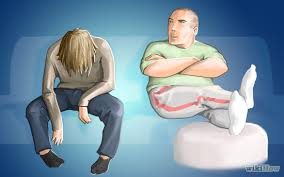People who use drugs (or drink) addictively are caught in a feedback loop. The addiction makes us feel like losers, blameworthy, perhaps worthless. We carry around this negative self-concept almost constantly — and it’s painful! Perhaps ironically, using or drinking seem the only way to relieve that pain. Yet the net result is that we feel even worse by tomorrow.
This is common knowledge in addiction circles. Yes, the thing that we are compelled to do to get relief is the thing that increases the need for that relief. In this post I want to ask what, if any, additional perspective is offered by IFS (Internal Family Systems) — to help us get out of this cycle.
If you haven’t followed my recent posts, please review, starting here, to get a sense of how IFS works.
 The first and perhaps biggest step is to start a dialogue with the part of us that does the escaping. They call it the Firefighter, because its job is to put out the fire of anxiety and self-abuse, as quickly and as effectively as possible, with no regard for the mess it leaves behind. We’re used to reviling that part: that pernicious, irresponsible urge to get loaded, high, smashed. That part is almost always the object of criticism (both from ourselves and from others).
The first and perhaps biggest step is to start a dialogue with the part of us that does the escaping. They call it the Firefighter, because its job is to put out the fire of anxiety and self-abuse, as quickly and as effectively as possible, with no regard for the mess it leaves behind. We’re used to reviling that part: that pernicious, irresponsible urge to get loaded, high, smashed. That part is almost always the object of criticism (both from ourselves and from others).
But what would it be like to offer “the firefighter” acceptance rather than scorn?
First, IFS goes looking for the source of the criticism. And there it is! It’s that familiar internal critic, whose job it is to root out and blast everything that’s wrong with us. That wasn’t hard to find. But now we’ve uncovered an internal war that seems unresolvable. Like the Arab-Israeli conflict. So let it lie for now. Let the combatants sit across from each other, the critic glaring at the Firefighter, and the Firefighter looking right back, snide and arrogant perhaps, knowing that it can win every battle, simply by smoking, shooting, snorting, swallowing pills, or drinking. Again. Tonight? Now!?
It’s no wonder people with addictions feel that their internal world is fragmented.
I have a psychotherapy client I’ll call “Maya”. Maya’s internal parts include a Firefighter (whom she calls Piya — again, a pseudonym), and “Piya” came into being (or at least into her awareness) during her reckless teenage years. She was a resident at a dance school in India. Her teachers were strict and the school had a patriarchal, top-down structure. Maya felt trapped and oppressed by all that discipline. So she’d break out at night.  Wearing her sexiest clothes, with a cigarette dangling from her lips, she’d hang out with other teens on the street corner. There was drinking, and smoking, cannabis, and sex. Piya took over at night, with the express purpose of having fun, feeling free, and saying Fuck You! to the authorities that ruled Maya’s life.
Wearing her sexiest clothes, with a cigarette dangling from her lips, she’d hang out with other teens on the street corner. There was drinking, and smoking, cannabis, and sex. Piya took over at night, with the express purpose of having fun, feeling free, and saying Fuck You! to the authorities that ruled Maya’s life.
Now Maya goes straight to the supermarket to buy wine, almost every afternoon, when the anxieties of her day threaten to overwhelm her. It’s Piya, once again, who’s in charge. After she comes back from the store, she goes out on her deck, with a sense of excitement and purpose, and starts drinking. She drinks and smokes cigarettes until, by late evening, she feels sick.
 In our therapy, guided by IFS principles, I encourage Maya to do two things: first, notice that Piya is made to feel dirty and blameworthy by a critical voice in her own head. She calls the critical part Madam Z (…not her real made-up name. Yes, even internal voices need pseudonyms) who has the character of a strict school teacher or aunt. Madam Z has much to contribute. We don’t want to banish her. But we don’t need her badgering Piya every time she appears. The second thing is to engage with Piya, not from the perspective of Madam Z but from the perspective of
In our therapy, guided by IFS principles, I encourage Maya to do two things: first, notice that Piya is made to feel dirty and blameworthy by a critical voice in her own head. She calls the critical part Madam Z (…not her real made-up name. Yes, even internal voices need pseudonyms) who has the character of a strict school teacher or aunt. Madam Z has much to contribute. We don’t want to banish her. But we don’t need her badgering Piya every time she appears. The second thing is to engage with Piya, not from the perspective of Madam Z but from the perspective of  Maya’s peaceful, accepting self. Her compassionate core — what IFS calls Self with a capital-S. That Self becomes more present, more tangible, when Maya takes a few minutes to do some deep breathing, to feel what it’s like simply to be inside her own body, alive and perceptive. Ironically or mysteriously, this Self may the same thing as the non-self identified by Buddhism.
Maya’s peaceful, accepting self. Her compassionate core — what IFS calls Self with a capital-S. That Self becomes more present, more tangible, when Maya takes a few minutes to do some deep breathing, to feel what it’s like simply to be inside her own body, alive and perceptive. Ironically or mysteriously, this Self may the same thing as the non-self identified by Buddhism.
When Maya addresses Piya in this way, she can empathize with her. “Of course you want to get us out of this state. Of course you’re set to take off to the store, buy some booze, and start drinking. It’s effective, it works. In fact, that’s the only thing you know how to do!”
 To forgive and embrace the part that’s simply waiting for a chance to get stoned…that’s radical. It flies in the face of conventional approaches to addiction, which demand that we get rid of this part, cast it out, or at least ignore it until it finally shuts up. So what’s the result? Doesn’t that just give us permission to get stoned more often, to drink more, to fully surrender to the addictive impulse? To do more push-ups in the parking lot (an infamous 12-step slogan).
To forgive and embrace the part that’s simply waiting for a chance to get stoned…that’s radical. It flies in the face of conventional approaches to addiction, which demand that we get rid of this part, cast it out, or at least ignore it until it finally shuts up. So what’s the result? Doesn’t that just give us permission to get stoned more often, to drink more, to fully surrender to the addictive impulse? To do more push-ups in the parking lot (an infamous 12-step slogan).
No, that’s not (necessarily) what happens. What happens is that the Firefighter gets some relief — a chance to relax. It’s not used to being accepted. It’s certainly not used to being understood. So when it perceives that that’s what’s coming down the pipe, the urge softens, the strength of the impulse or compulsion is diminished. Now that it’s not being attacked, this part can hang around and explore other options. Now there’s a chance to wait and see. Maybe tonight things aren’t so terrible. Maybe it’s not necessary to douse the flames and make a huge mess that (it knows very well) will make tomorrow even worse.
And there’s a bonus that you won’t really get until you try this approach. Using, drinking, putting out fires, real or imagined, day after day, is a lot of work. The part that rushes into this role, ready to do it all over again on a moment’s notice…that part can use a break. Sometimes, even the crazy parts of us just want to sit back, relax, and do some channel surfing, play a game, browse the net, or take a nap. In the next couple of posts I’ll explore further steps we can take to break the feedback cycle of addiction.

Leave a Reply to Annette Cancel reply